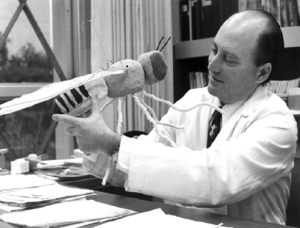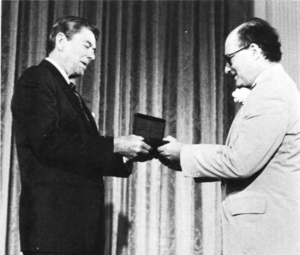Seymour Benzer facts for kids
Quick facts for kids
Seymour Benzer
|
|
|---|---|

Benzer with a Drosophila model, 1974
|
|
| Born | October 15, 1921 Bensonhurst, New York City, U.S.
|
| Died | November 30, 2007 (aged 86) Pasadena, California, U.S.
|
| Alma mater | Brooklyn College (BS) Purdue University (PhD) |
| Awards | Gairdner Foundation International Award (1964, 2004) Louisa Gross Horwitz Prize (1976) Harvey Prize (1977) Thomas Hunt Morgan Medal (1986) Wolf Prize in Medicine (1991) Crafoord Prize (1993) Mendel Medal (1994) International Prize for Biology (2000) Fellow of the Royal Society Gruber Prize in Neuroscience (2004) |
| Scientific career | |
| Fields | Physics, molecular biology, behavioral genetics, chronobiology, neurogenetics |
| Institutions | Purdue University California Institute of Technology |
| Thesis | Photoelectric Effects in Germanium (1947) |
| Influences | Roger Wolcott Sperry, Max Delbrück, Salvador Luria, Alfred Sturtevant |
| Influenced | Richard Feynman, Francis Crick, Sydney Brenner |
Seymour Benzer (born October 15, 1921 – died November 30, 2007) was an American scientist. He started as a physicist and later became a famous molecular biologist and behavioral geneticist. His work helped us understand how genes control our traits and behaviors. He led important research labs at Purdue University and the California Institute of Technology.
Contents
About Seymour Benzer
His Early Life and Schooling
Seymour Benzer was born in the South Bronx, New York. His parents were from Poland. He had two older sisters. As a boy, he loved science. He even dissected frogs he caught! For his 13th birthday, he got a microscope, which he said "opened up the whole world."
A book called Arrowsmith by Sinclair Lewis really inspired him. He even copied the handwriting of a scientist character from the book. Benzer finished New Utrecht High School when he was only 15 years old.
In 1938, he went to Brooklyn College to study physics. Then, he moved to Purdue University to get his PhD in solid state physics. While there, he worked on a secret military project. He helped develop better radar and found a special germanium crystal. This work was important for creating the first transistor, a key part of modern electronics.
His Family Life
When Seymour was 16, he met Dorothy Vlosky (nicknamed Dotty) at Brooklyn College. She was a nurse. They got married in New York City in 1942. They had two daughters, Barbie and Martha Jane.
Seymour Benzer passed away in Pasadena, California, after having a stroke.
Benzer's Scientific Discoveries
Exploring Molecular Biology
After getting his PhD in 1947, Benzer became a physics professor at Purdue. But he was inspired by a book called What Is Life? by Erwin Schrödinger. This book made him wonder about genes and a "code" for life. So, Benzer decided to switch to biology.
He spent two years studying bacteriophage genetics at the California Institute of Technology. Then he returned to Purdue. There, he created a new way to study genes using T4 bacteriophage rII mutants. He found that genes were not just one solid piece. Instead, they were made of many smaller parts. He also showed that genes were arranged in a line.
Benzer's work proved that mutations could happen in many different spots within a single gene. His methods were so precise that he could see changes at the level of a single nucleotide (the building blocks of DNA). He also described different types of mutations, like deletions and point mutations.
His discoveries were very important for other scientists. His work helped Francis Crick and Sydney Brenner figure out the triplet code of DNA. This code tells cells how to build proteins.
In 1967, Benzer left phage genetics. He went back to the California Institute of Technology to study behavioral genetics.
Understanding Behavior Through Genetics
Seymour Benzer was a pioneer in the field of behavioral genetics. This field looks at how genes affect behavior.
Benzer's Approach to Behavior
In the 1960s and 70s, Benzer had different ideas from another leading researcher, Jerry Hirsch. Hirsch thought behaviors were too complex to be controlled by single genes. Benzer, however, believed that even complex animal behaviors could be linked to specific genes.
This led to different ways of doing experiments with Drosophila (fruit flies). Hirsch would breed flies for many generations to select for certain behaviors. Benzer, on the other hand, would create random changes (mutations) in flies. Then he would look for flies with altered behaviors. Both approaches helped the field of behavioral genetics grow.
Key Discoveries in Behavior
Benzer used his method to study many behaviors in fruit flies. These included how flies react to light (phototaxis), their daily sleep-wake cycles (circadian rhythms), and how they learn. He even invented special tools, like a device to sort flies based on their reaction to light.
He found mutants (flies with genetic changes) that affected:
- Vision: Flies that couldn't see light or reacted negatively to it.
- Movement: Flies that were slow or uncoordinated.
- Stress: Flies that got "freaked-out" easily.
- Nerve and Muscle Function: Flies with problems like photoreceptor degeneration.
- Learning and Memory: Flies like rutabaga and dunce, which had trouble learning.
Benzer and his student Ron Konopka found the first mutants related to circadian rhythms. They found three types of mutants: flies with no rhythm, a shorter rhythm, or a longer rhythm. These changes were all in the same gene on the X chromosome, which Konopka named period. This was a huge step in understanding how genes control daily cycles.
Later, Benzer and Michael Rosbash showed that the protein made by the period gene is mostly found inside the cell's nucleus. This work was very important for the study of circadian rhythms. In 2017, Drs. Rosbash, Michael W. Young, and Jeffrey C. Hall won the Nobel Prize for their work on these genes.
Benzer also studied how genes affect aging and brain diseases in fruit flies. He looked for mutants that lived longer. In 1998, he found a long-life mutant fly named Methuselah. This fly had a change in a gene that helped it handle stress better, making it live longer. One of his last projects looked at how diet affects how long an organism lives.
Exploring Cancer Research
In 1978, Benzer's wife, Dotty, was in the hospital with breast cancer. Also, his friend and mentor, Max Delbrück, was diagnosed with cancer. These events made Seymour Benzer interested in cancer biology. He started attending conferences about breast cancer.
Benzer later married Carol Miller, who studied brain diseases. In the early 1980s, they used special staining methods to find genes that were very similar in both flies and humans. This work helped show how much we can learn about human health by studying fruit flies.
Awards and Recognitions

Seymour Benzer received many important awards for his scientific work:
- Fellow of the American Academy of Arts and Sciences (1959)
- Gairdner Foundation International Award (1964, 2004)
- Albert Lasker Award for Basic Medical Research (1971)
- Louisa Gross Horwitz Prize from Columbia University (1976)
- Harvey Prize (1977)
- Dickson Prize in Science (1978)
- National Medal of Science (1982)
- Rosenstiel Award (1985)
- Thomas Hunt Morgan Medal (1986)
- Ralph W. Gerard Prize in Neuroscience (1989)
- Wolf Prize in Medicine (1991)
- Crafoord Prize (1993)
- Feltrinelli Prize (1994)
- International Prize for Biology (2000)
- NAS Award in the Neurosciences from the National Academy of Sciences (2001)
- March of Dimes Prize in Developmental Biology (2002)
- Bower Award and Prize for Achievement in Science (2004)
- Albany Medical Center Prize (2006)
He was also a member of several important scientific groups, including the French Academy of Sciences, the U.S. National Academy of Sciences, and the Royal Society.
Books About Benzer
Two books have been written about Seymour Benzer's life and work:
- Time, Love, Memory: A Great Biologist and His Quest for the Origins of Behavior by Pulitzer laureate Jonathan Weiner (1999).
- Reconceiving the Gene: Seymour Benzer's Adventures in Phage Genetics by Lawrence Holmes.
See also
- Phage group
- T4 rII system

